- HOME
- BEST POKER TRAINING SITES
- POKER GUIDES
- ONLINE POKER ROOMS GUIDE
- POKER NOTES LIVE APP
- MORE
The game of poker has been around for a while and it’s seen its fair share of funny, extraordinary, and even tragic moments. Some poker legends represent moments that were important milestones in poker history, sometimes even playing a role in how the game was shaped over time. Others are merely entertaining anecdotes that fans of the game enjoy tremendously, simply because they seem so hard to believe or make them feel blessed that they live in a different time where sitting down to play doesn’t mean risking your life. Here, then, are three poker legends that you’ll enjoy reading about.
Almost all poker players know about the dead man’s hand, i.e., Aces and Eights, but not everyone knows the story behind the myth. Most everyone has heard bits and pieces, but the story has been told and retold so many times that there are dozens of similar but different variations.

Wild Bill Hickock
According to the best facts available to us these days, the term was coined in the late 1800s and is closely related to “Wild Bill” Hickock, a famous marksman who acted as a sheriff of his town. In addition to his skills with guns, “Wild Bill” was also known for his skills at the poker table.
According to some accounts, on August 2, 1876, Hickock sat down to play what would be his last poker session. Always careful, he would usually avoid sitting with his back to the door, but it so happened that the only available seat on that fateful day was facing the wall.
In the midst of the hand, a man walked into the saloon, approached him from behind, and shot him point-blank in the head. The story, which first came to life in 1886, about a decade after the incident, claims “Wild Bill” was holding two black Aces and two black Eights in his hand at the time of the shooting – the dead man’s hand.
It is impossible to fully verify the truth of this story. Hickock was, indeed, shot on that day, but whether he was involved in a game and was actually playing a hand when the shooting happened remains a mystery. All we have today is the legend about the famous marksman who met his death not out in the wild but sitting at the poker table.
In 1979, Hickock was a member of the first class of players enshrined in the Poker Hall of Fame.
READ MORE: 7 Ways in Which the Poker Hall of Fame Should be Changed
Some poker legends, like the one above, are old, with their age adding to their mystique and appeal. Others are of a more recent vintage but are equally as entertaining and fascinating. The tale of Isildur1, a Swedish unknown (at that time) who became a legend at the highest stakes played online, is well known to many fans of the game but it is worth recounting.

Viktor Blom; aka, Isildur1
It was in the late 2009 that the man who was later revealed as Viktor Blom took his shot at the highest of stakes, taking on some of the biggest names around: Tom Dwan, Patrik Antonius, Phil Ivey, and whoever else was willing to play. Isildur1 was up for a challenge and wasn’t going to back down no matter what.
In the short period between September and October 2009, Blom went on a huge winning streak, accumulating around $6,000,000 in winnings. His extremely aggressive poker strategy, combined with some timely rungood and the fact no one knew who this player was or what he was trying to achieve, helped him create a buzz in the online poker world that had never been seen before. Everyone was tuning in to poker forums to see how Isildur1 was doing at the tables, wondering how the tale would end.
The epic upswing came to an abrupt halt when some top pros, including most notably Brian Hastings, put their heads and knowledge together to take Isildur1’s game apart. Although some in the poker community considered this to be a somewhat underhanded strategy when it was revealed, it worked. Isildur1 was finally stopped and his upswing turned into a $2.4 million downswing not long after.
Beaten but not broken, he continued battling at the highest of stakes. It was in early 2011 that his identity was finally revealed as that of Viktor Blom when the Swede was signed by PokerStars. His sponsorship with the online poker giant wasn’t a particularly long one but his legend remains to this very day.
There is probably no poker fan out there who hasn’t seen at least one episode of the legendary High Stakes Poker TV show. Gathering some of the best and biggest players of the time, it was, according to most, the best poker show ever to have aired. It was the mix of high stakes cash game action, great personalities, table talk, and high quality commentary that made the show the success it was.

But, how did it come to be?
According to Mori Eskandani, the show’s main producer, it all started with Poker Hall of Famer Johnny Chan. Chan walked up to Eskandani while he was having a dinner with network producers who wanted to create a pilot for a poker show. This was back in 2005, when the poker boom was in full swing.
Johnny told Mori and the network producers about a $700,000 pot he had lost that evening. At that moment, the network was struggling to come up with a concept for a poker show and Johnny’s story hit the right spot.
The network programming VP called Eskandani later that night, intrigued about his relationship with Chan and the $700,000 pot, which he believed had occurred in a tournament. When Mori explained to him it was a cash game pot, where players played for actual dollars, the VP was instantly hooked and asked if they could bring that action to TV.
Mori said yes – and the rest is history!
Have you ever seen a dog chasing a car? It’s a hopeless task. The poor dog never catches the car. The dog is a chaser – a loser. Playing poker, there are lots of chasers; and they usually lose most, if not all, of their chips before the evening is over, no matter the game or the stakes. Even more so if there is a cost to play, as is the case in cardrooms and casinos all over the world.
More often than not, after the flop you will find yourself with a hand that almost always must still improve to take the pot. These are “drawing hands.” The cards that will complete your draw to a “made hand” – one that could win without further improvement – are your “outs.” Count them; the more the merrier – the better your chance of connecting. (Of course, it’s best to connect to the “nuts” – a hand that cannot be beat, considering the cards shown on the board. But that is relatively rare.)
Many poker players are prone to chase; why? Answer: They know that if they catch the right card, they are very likely to win the pot. (Not always, of course; unless they catch the nuts.)
Let’s illustrate using a typical chasing hand: In the big blind in a $4-$8 limit hold’em game, you have been dealt 7s-8h. Several opponents limp to see the flop; and, with no raise, you get a free flop. (Tip: Never refuse a “free” flop.)
Orleans has a new poker game called ‘Free Flop Hold’em.’ It’s Hold’em without the preflop betting round. It sounds like a rock’s dream game.
— John Mehaffey (@John_Mehaffey) May 25, 2017
The flop is Jd-9c-2h. You now have caught a draw to an inside straight, Jack-high. You need to catch a 10; if that happens, your hand is highly likely to win the pot. There are four 10s in the deck; so, you have four outs. That’s much too few to warrant further investing in that hand. Fold to a bet and save your chips for a better opportunity. (Tip: Don’t goof! The chips you save are at least as valuable as those you win.)
If you had been dealt As-Kh in the hole from a middle position, and the flop was Jd-Qc-2d, you would have the chance of catching any 10 for the Ace-high straight (4 outs), plus either an Ace (3 outs) or a King (3 outs) on the turn or on the river. In total, you would have 10 outs (4 + 3 + 3) that are likely to make your hand a winner.
Using the 4-2 Rule, with both the turn and river to come, multiply your outs by 4. You have approximately 40 percent (4 x 10) chance of connecting with a made hand. Your card odds are about (100 – 40)/40 = 3/2 = 1.5-to-1 against connecting.
Remember, we’re talking about limit hold’em. There is a raise before you, so it will cost eight chips to stay to see the turn. The pot now contains about 32 chips. Thus, the pot odds are 32-to-8 = 4-to-1, substantially higher than your card odds (1.5-to-1). That’s a very high positive expectation. In other words, the risk is well worth the investment. In the long run, you will make a good profit by playing that hand to the river.
Contrast this hand with the first case, where you were chasing a long shot with only four outs, too few to warrant calling the bet on the flop. I regard anything less than six outs as chasing rather than investing (pot odds higher than the card odds).
Of course, the risk of becoming a chaser is not confined to the poker sphere. The same problem can arise when playing other games of chance, whether we are talking about table or slot games. Many slot enthusiasts tend to chase those big jackpot winnings, and more often than not, will ignore the importance of establishing a budget limit that helps them to stop betting if things go south. Why?
Again, players know that higher bets on certain jackpots will give them a better chance of triggering the jackpot feature, hence the hope that the money put out will be regained threefold. Although there have been cases where this has happened, placing bigger bets also means bigger losses. At the end of the day, there is no exact science to it, for as all slot players know, every single spin on every slot game is a random event – the way slots work is by using a random number generator so there is no way you can predict accurately when a jackpot will pay out.
This is not to say that seasoned players cannot spot patterns or make informed decisions on which games to bet on by looking at various criteria pertaining to the specific slot game. This can be done easily with Network Progressive Jackpots. What are they and how are they different from the typical Single Slots Jackpots?
As explained by one of the top casino review sites, CasinoTopsOnline:
“These slots draw a small portion of the bets placed by gamblers at different online casinos. All connected by the network the game runs on (such as Microgaming), playing these slots could mean that you’re feeding a jackpot along with thousands of other players. With this many bettors adding to the progressive jackpot, it can grow to be worth multiple millions.”
So how can you get better at spotting a potential win? The fastest and easiest way to do it would be by analyzing past wins. By looking at things like the size of the jackpot when it is won (for instance, finding a jackpot on a slot tends to pay out when they reach between $1 million and $3 million), or by looking at the time frame of when jackpots tend to be won, for example if they’re won every two to four months, etc. These are all things that, again, do not give any guarantees, however, they can shed some light on certain trends.
The moral of the story: Be an investor, never a chaser. Chasers are losers!
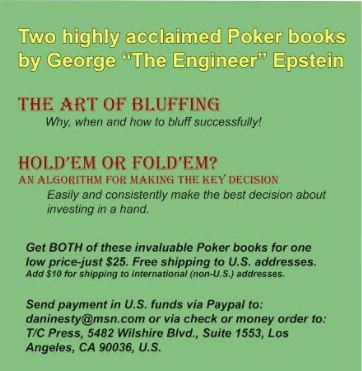
The game of poker is constantly changing and evolving. Not too long ago, knowing some basic strategy and having the willingness to learn was more than enough to beat both live and online games for decent profit. These days, however, to be a winner at any reasonable stakes, much more is required. An increasing number of poker players have solid skills and many of them work constantly to improve their theoretical knowledge of the game. So, how does the one stay ahead of the curve in such an environment? According to Elliot Roe and his new A-Game Master Class, which can be found on the Run It Once poker training site, there is more to beating the game than just knowing a lot about math and ranges.
This Master Class puts an emphasis on what’s often dubbed the “mental game” and focuses on how one should set their goal and work towards achieving them through practice that isn’t necessarily poker-specific: setting goals, being in the right mind-frame, eating and sleeping properly, and much more.
The entire A-Game Master Class is divided into six large modules, each of them containing a number of video lessons focusing on the particular aspects of the module. Roe begins by first explaining what it is that prevents people from achieving success in poker (notably, his thoughts and ideas could be applied to many other areas as well).
The course goes on to try and identify some of the most common obstacles that prevent people from achieving their goals, such as lack of vision, lack of skills, lack of energy, and detrimental mental programming. While the first three are fairly self-explanatory, the last one is quite interesting as Roe proceeds to explain how there are certain presets in our brain that prevent us from moving forward even though they act as protection systems of sorts.
After identifying what the biggest inhibitors are, the course moves on to explain approaches and strategies to tackle these issues. Roe identifies and explains some core principles that can help with this, constantly emphasizing the importance of understanding how poker fits into your wider life journey.
Instead of focusing on just one aspect of the game (such as making money), he explains that striving for poker excellence only makes sense if achieving this goal would actually make you the best version of yourself and would correspond with the rest of your life values (family, friends, free time, etc.). Only when things are set up in this way does the journey make sense and are the chances of making it much better.
In the following three modules, the course deals with effective methods and strategies of countering negative things in your life and adopting habits that are required to become an A-Game player. In these lessons, Roe touches upon many concepts that have been talked about time and time again, but he approaches them with a fresh perspective.
For example, he explains the importance of understanding that the only thing we can control in poker is our input, i.e., our own decisions. The outcome of any particular hand, session, or a tournament should be regarded as irrelevant as long as we’re happy with the input, i.e., with the decisions we’ve made.
The course also explains the importance of energy for your overall success. Eating and sleeping right is much more important than many players realize, and even some of the best in the game often underperform because they play without enough energy. Roe goes into great detail about what to do to achieve higher levels of energy and gain an edge over your competition.
One of the biggest struggles many players have to deal with is maintaining their focus for long periods of time. Once the focus is gone, their performance starts to decrease, leading to less-than-optimal results.
Therefore, a significant part of the A-Game Master Class deals with focus and strategies that players can employ to ensure they stay focused for longer periods of time. Roe devised and explains his focus formula, which takes into account several important aspects that, when combined, are instrumental for staying focused while playing.
Of course, quite a few lessons in Elliot Roe’s A-Game Master Class also deal with emotions and the role they play in the life of any poker player. Emotions are natural to human beings and there is no way to avoid them. In fact, Roe suggests that even if we could, we shouldn’t turn off emotions, as it would likely adversely affect other areas of our lives.
What we can do, however, is assert control over those emotions and not allow them to influence our decision-making when playing. Once again, this is nothing new, but Roe helpfully takes you through the entire process behind keeping control over your emotions, from recognizing the trigger, experiencing the emotion, and deciding (not) to act on it.
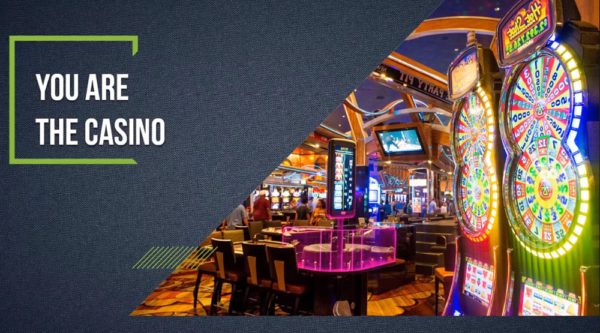

The final video in the A-Game Master Class deals with the issue of downswings, as it’s one of the biggest issues that almost all poker players face. Roe explains that it is important to be able to think outside of the box and to realize that downswings only exist within arbitrarily assigned time frames. In other words, one’s ability to change the time frame is likely to change one’s view of a downswing. A simple, but brilliant concept!
In addition to all the content in the main course, the A-Game Master Class also gives you access to an extensive MP3 library. These are files you can download to your portal device such as your phone and listen to them whenever you have time or feel the need.
These aren’t theoretical lessons but rather voice files designed to help you relax and focus in specific situations like:
These MP3s are a nice addition to the course and definitely add to its overall value and usefulness. Designed to target very specific situations that almost every poker player has to deal with, these files will help you remember things that you’ve learned in the main course and always bring your A game to the tables.
Like every poker course out there, at the end of the day you want to know if the cost is worth the money? Elliot Roe’s A-Game Master Class costs $999, so it’s not really a super-cheap one. With that said, getting top-quality information, training, and tools for success costs money. This course offers 100% pure quality, and is practically guaranteed to lead to improved results at the table if you’re willing to take it seriously and work through it as Elliot Roe intended.
READ MORE: An interview with Elliot Roe
Classic poker courses focus on strategy and, as such, only require players to think about concepts discussed in the lessons and try to implement them into their game. Even if you can’t wrap your head around all of the concepts, your game will likely get better if you’re able to successfully integrate certain segments of the strategy into your game.
This course is very different, though. It tries to explain how you should change your entire approach to poker (and even your life, to some extent) if you’re really set on making it. Making changes like these doesn’t happen overnight and requires a lot of effort and dedication. Throughout the course, Roe asks the viewers to pause the videos to perform certain exercises, make lists, etc.
In short, the course will only work for you if you want it to work.
As such, the $999 price tag is justified in this writer’s opinion. Elliot Roe knows what he’s talking about, as he’s worked with some of the game’s best and has helped them achieve some really impressive results. You just need to be aware that this course isn’t some sort of a magic pill that can instantly turn you into the next great poker success story. If you’re willing to put in the work and have an open mind to accept the advice and follow the guidelines, A-Game Master Class can help you get where you want to go as a poker player.
The term “probe bet” describes a bet fired out of the position on the turn or the river when the initial raiser decides to check back the flop instead of firing a continuation bet. It is an approach whereby the player defending from the blinds tries to take control of the betting in the hand by betting themselves, allowing them to potentially win the pot on the turn or river by either bluffing or realizing their equity and winning at showdown.
Probe bets can be quite powerful when used correctly but, like all other strategies, they can also be dangerous if used too often or in spots that are unfavorable to such an approach. In this article, we’ll give you three top tips for how to implement probe betting into your overall poker game-plan.
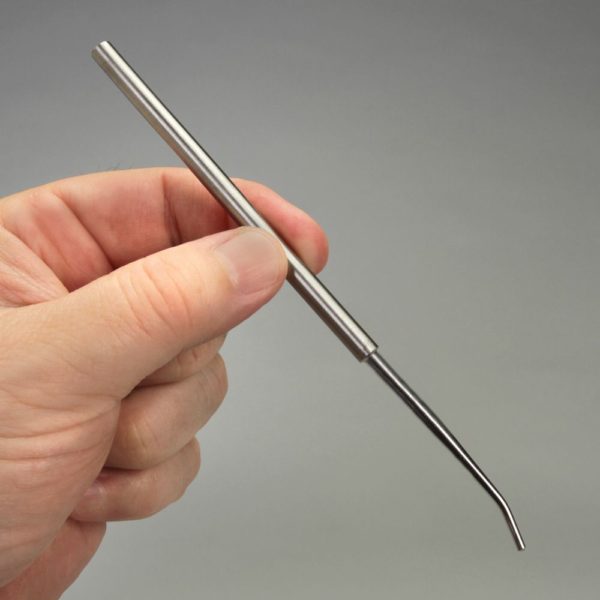

A different kind of probe… 😀
When considering making a probe bet, look at the board texture and how it corresponds with yours and your opponent’s perceived range. Lower cards and connected boards are usually ones that are favorable for the player in the big blind position to try and take control of the betting by firing on the turn, especially when the turn card doesn’t change the situation too much and is unlikely to help your opponent.
Unlike with flop leads, your opponents will have a much harder time continuing with just overcards on the turn. Since there is just one more card to come and even catching the perfect card is not guaranteed to produce a winner on these low, connected boards, they’ll be forced to fold often enough to make probe bets a very effective tool in these situations.
If you have a hand with decent equity on the flop or pick up some equity on the turn, you can go ahead and fire a probe bet even if the turn card might be in your opponent’s range. Your equity combined with the fold equity on the turn as well as bluffing possibilities on the river makes probe betting a very profitable proposition in most cases.
Of course, you need to be aware that sometimes you will find yourself in a situation where your opponents check back with a monster or improve to a big hand on the turn. Since you’re out of the position, these spots can be somewhat difficult to navigate, but overall you will be making money with probe bets here and that will more than compensate for the times when your opponents wake up with big hands.
More often than not, a flop check will indicate a weak range from recreational players, so you should take advantage of that.
If you’re playing poker online, there are several important stats you’ll want to consider when deciding whether to go for the probe bet or not. These Hold’em Manager or Poker Tracker stats will be quite helpful if you’re up against an opponent that you have a decent sample size on, as you’ll be able to come up with some pretty accurate guesses about their tendencies.
For example, players with a very low c-bet percentage are usually the ones who only continue with made hands, i.e., if the flop helps them or they already have a big pocket pair. When these players check back on the flop, you’ll be able to comfortably fire out a probe bet on the turn and expect to get them to fold a high percentage of the time.
Obviously, if you are playing against really tough competition, you are unlikely to exploit them because they will have quite balanced ranges and will understand frequencies. So, your best bet is to also play a balanced strategy and leave some strong hands in your checking range on the turn so that you can check-raise and apply pressure back on your opponents.
However, if you are up against a weaker player, you can and should make many probe bets. Basically, in almost all cases when you are not sure what to do in these situations, (probe) betting will be a better option because these players will be massively over-folding either on the turn or river in these situations.
I recently had the chance to sit down for an in-depth interview with Emily DeLaine, one of the most popular dealers at the World Series of Poker both on the felt and in the Poker Twitterverse. She just completed her fifth year of dealing at the WSOP, and had the honor of dealing the Main Event Final Table for the third consecutive year.
Emily is popular in no small part because of the congeniality she brings to every table. Her energy is contagious and she takes a genuine interest in every player’s experience. Dealers can play a large role in how players interact with one another other during the natural hostility of a poker game, and it’s a role that Emily takes seriously. She has an understanding of the need for poker to be entertaining, and it comes across in how she goes about her work.
Originally from just outside the Atlanta area, Emily graduated from the University of Georgia with a degree in Sociology. She spent her post-college career in a variety of corporate roles before taking on work as a part time poker dealer in Oregon. On a whim she came to work at the Rio in 2015, and she hasn’t looked back since.
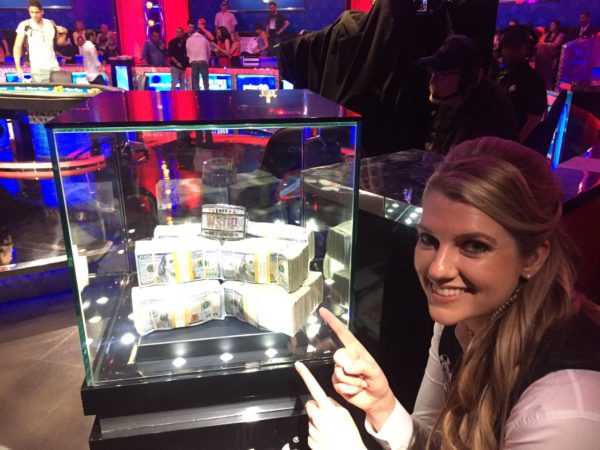

Your path from college to dealing at the final table of the World Series of Poker Main Event has taken a lot of twists and turns. What was life like after college and how did you find your way to the WSOP?
I graduated college in 2008, which was the worst time to graduate college in America. We were wondering what we were going to do and how we were going to get jobs. We spent a lot of time playing World of Warcraft and trying to figure it out. After I graduated I moved to Austin, TX, with my boyfriend at the time and I set out to get any job I could find. It was difficult. I had a Bachelor’s degree and nobody was hiring for anything.
I worked at a custom cake bakery until I found a job in the accounting department of a lobbying firm as a clerk doing filing and other basic tasks. I was really interested in public policy, and my undergrad degree was in Sociology, so it had potential. I worked there for four years, and during those four years I went to a graduate program at the University of Texas for a Master’s Degree in Public Policy. I worked my way up in that lobbying firm to be involved in additional things like fundraising and getting involved in policy.
I ended up quitting when a male intern who I had hired was promoted over me. I kept getting relegated to smaller tasks. They wanted me to be the receptionist forever while I had the same degree as all of the men they were hiring. I was even attending the same school as them!
That sudden change jarred me. I was 26 and was wondering whether or not the corporate world was something I wanted to still be involved in. I’m anti-structure and I don’t like norms that are there for other people to benefit.
I began applying for graduate programs in Sociology, got accepted to the University of Oregon, and moved there but I struggled immediately. Grad school is tough, even for the strongest person, and the archaic nature of modern academia makes it a lot tougher. Not everyone has the cultural capital to succeed in that world.
I struggled, but I needed a part time job, so I started dealing poker. There are social clubs in Oregon where poker is legal. I worked there for a year and in the summer of 2015 I thought “Why not go to the WSOP?” It was perfect. It sounded fun and exciting.
Your prominence at the WSOP has risen quickly, and you’ve had a lot of great opportunities in a short time. How did you grow in the job so quickly?
That was one of the most surprising things. During my first year at the WSOP, I worked the cash games most of the time and it was amazing. I crushed it! I loved the challenge of dealing mixed games. I think I got noticed because I would go over and deal 2-7 Triple Draw and other complicated games with no problem.
Finally got a final and it just so happens to be my favorite tournament! 10k Dealer’s Choice, and no surprise, @shaundeeb is here to give me a hard time. Oh, and to crush it… #WSOP2019
— Emily DeLaine (@WSOPSweetheart) June 17, 2019
The following summer I still dealt a lot of cash games, but I started doing more tournaments because what I learned is that you can hustle cash games all you want, but it can be exhausting and there’s a cost to your health. I went over to the tournament side in order to save my back and meet cool people.
The next year I was chosen to be in the ESPN featured table rotation. There were about 30 or 40 of us and we dealt the featured tables. They narrowed it down to the dealers they wanted for the final table of the Main Event and I was fortunate enough to be in that small group.


Emily and the other 2017 WSOP Main Event final table dealers
What qualities do you think make you stand out as a top dealer?
I have an entertainer part of me. I bring something to a featured table that I think they like in that I smile and get the players talking when maybe they normally wouldn’t. I want it to be entertaining!
Solid read bro…
— Emily DeLaine (@WSOPSweetheart) July 15, 2019
How does it feel to deal at the final table of the World Series of Poker? How do you handle the nerves?
It’s fun and cool and weird and there’s a crazy effervescence going on. I get really calm up there. Some dealers can struggle with their nerves and make mistakes, but I realized quickly that you have to be calm or you’re dead.


Emily with Lon McEachern, Norman Chad, and Antonio Esfandiari
You have to love what you’re doing to show that kind of enthusiasm. What do you love about poker?
I love games. Period. Put me in a room with 20 games and I’ll play them all. I’ve always been that way since I was a kid. We’d be in a car on a long trip and we’d have all these trivia games and I’d play for hours. I was very annoying about it. The more I got into poker, the more I realized there are actually 10 different games going on at the same time. On my bucket list is learning how to play a lot better. I have some skill. I always say I’m really dangerous when I do play because I know what I should do but I don’t really know why.
LFG will always mean “Looking for Group” to this gamer girl. It gets so confusing these days. #LFG
— Emily DeLaine (@WSOPSweetheart) May 11, 2019
You won an online satellite into the Casino Employees tournament at this year’s WSOP. Are you sure you don’t know what you’re doing?
I’d rather get lucky than play well! That was cool. I was on the fence about playing in the event but I thought I may never get this chance again. I’m very risk averse. I’m definitely more of a dealer than a player, and I think that’s odd for this industry. I always want to play, but I can never justify the $500, so this year when I won a seat for $30 I was really excited.
Guess who won the seat to the Employee event this year!?! #sattyseatwinner #wsop2019
— Emily DeLaine (@WSOPSweetheart) May 27, 2019
Your twitter (@WSOPSweetheart) is very popular throughout the poker community, and you’re not afraid to express your opinion. How do you view your role in addressing the game’s important issues?
I speak for those who can’t and I take that very seriously and I try to be strategic and elevate the conversation between players, management, and dealers. A lot of times it gets garbled. I try to be a conduit of information.
PSA to everyone at the WSOP, there are many new dealers this year. Please be patient & kind, as hard as that can be sometimes. This is how we retain experienced dealers from year to year. We were all new to the WSOP at some point and I remember the steep learning curve! #WSOP2019
— Emily DeLaine (@WSOPSweetheart) June 1, 2019
The dealers often get left out of the conversation. More and more, dealers today are required to do things that shouldn’t necessarily be left on the dealer. Many people don’t think about the mechanics of the game and how the game is happening in the dealer’s head.
I talk a lot about the physical aspect of dealing, and I get so many eye rolls. I have to remind people that smaller mechanical motions are far worse for your body than lifting heavy things. We can’t get workers comp from back pain issues or carpel tunnel. Sitting for so long is terrible for your health.
I try to explain that and sometimes people have a caveman mentality and want to say “you don’t have it so bad.” I don’t like to live my life by “it could be worse” because it can always be worse, but that doesn’t mean you shouldn’t fight for things to get better.
If I ever quit dealing rest assured I’ll never quit speaking up for the least powerful in the industry. Dealers have no voice, yet make up the majority of event staff. Players have an ethical obligation to consider the working conditions of staff at every venue. #poker #neverquit
— Emily DeLaine (@WSOPSweetheart) June 29, 2019
What is the lifestyle like for a poker dealer? What challenges do you face outside of the physical requirements of the job?
I think it’s important to focus on the difference between a house dealer and a travel dealer. They are two totally different things. Traveling dealers, or event dealers, go from gig to gig all over the country. They’re either temporary, on call, or seasonal. Usually you have to know someone to get on a crew. Some people work gig after gig, which is exhausting and expensive. Players can empathize with this, too. We travel all the same circuit stops and we have to pay for everything. So many players ask “do they put you up?” and I’m like “are you kidding?!”
Everyone get some good sleep tonight! WSOP Main Event starts tomorrow!!! 🎉😘 #WSOP2019
— Emily DeLaine (@WSOPSweetheart) July 3, 2019
There’s a lifestyle of living in your car. I haven’t had a home since I left Oregon two years ago. I decided to go on the road full time after my third year. I thought it would be fun for a while, and it is, but it has its pros and cons. I think I’m at the worst age for it. I wish I were doing this at 23, but maybe I would’ve been terrible with my money because working in a casino and being surrounded by that kind of cash can change the way you think about spending and saving.
How have the financial challenges of being a traveling dealer evolved?
It can be really swingy. You might go to a busy stop where there is a lot of work, but they over-hired. That will make your share of the pie less at the end of the event. As temporary employees, we don’t have access to healthcare and retirement benefits, and there are also differences in your legal status as an employee depending on where you are working. Sometimes you’re an independent contractor and sometimes you’re an employee of the event. In the past you could claim all of your business expenses as an independent contractor because you were your own business. If you were an employee, you could claim unreimbursed employee expenses.
The dealer karma for these players is at an all time high. Thank you! May no player suffer from all the dealer sugar coma though, 😂! #WSOPMainEvent #WSOP2019
— Emily DeLaine (@WSOPSweetheart) July 5, 2019
The recent tax cuts did away with that, so now when I go stay at the Hard Rock in Florida, which is usually one of the best stops, I can’t claim my lodging and travel and food against my income. So it can really hurt you financially, especially if you itemize your taxes, which a lot of dealers do because they go to so many gigs and it starts to add up. That’s probably one of the main reasons that I’m looking to transition out of being a traveling dealer.
Were there issues balancing life in academia with life as a top poker dealer?
Two years ago I decided to take a year off of school because I was behind and I was struggling. I sold my home in Oregon and brought all my stuff to Vegas. It’s still in storage. I think I invested too much energy into poker and I did that in a very self-protective way. It was easier than a PhD program and it had more rewards; and if you think about it, I had been greatly rewarded. I was getting a lot of positive vibes from poker.
After that year off I had a lot of tragedy. My mom was struggling with heavy losses after Hurricane Michael. My step-mom had an aggressive form of cancer that she has been fighting, and my dad got cancer, so I abandoned my program because it got too complicated and difficult. I don’t think I can go back. I haven’t talked to anyone there since I left.
You’ve had a lot of transition in life. Do you see a long-term future for yourself as a dealer? What’s next?
I would like to go to Law school, but I don’t want to lose ties to the poker community because I love it. I have to figure out how to make my life meaningful and still be in poker.
I will always enjoy dealing to a group of really great people, having a good conversation, running a great game, and enjoying that social aspect of it. That’s what I love and that’s what I want to do.
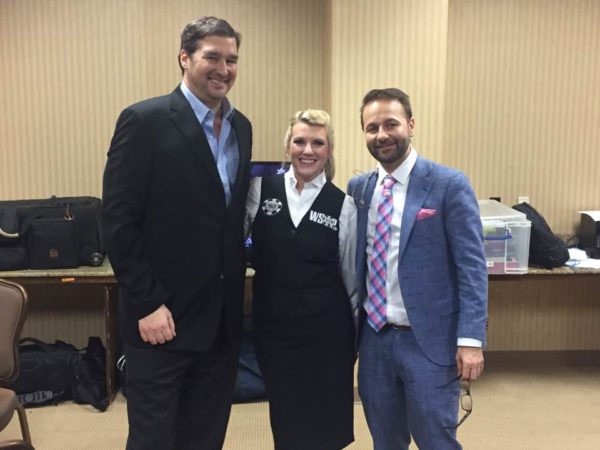

Emily with Phil Hellmuth and Daniel Negreanu
A deep run in the Main Event at the World Series of Poker is amazing. But not for the reasons you might think. Sure, I made $50,000 for my 225th place finish this year, but that barely got me even for the summer. I would have made more driving for Lyft. I would have made a lot more playing cash games all summer. But the only reward for playing cash games is, well, cash.
Ok Twitter, make me feel better. Complete this sentence.
“Busting day 5 of the main sucks, but at least… ”
— Chris Wallace (@foxpokerfox) July 11, 2019
I didn’t win a bracelet this year. I didn’t even come close. I was featured on ESPN for part of a day, but television coverage is not particularly exciting just for the sake of being on TV. The reasons we tell ourselves we play poker, the money, the glory, the fame, the competition, didn’t do anything for me this year.
What made my year was the reminder that a bunch of people are rooting for me. My deep run in the Main Event, and playing at the feature table on ESPN, served as an excellent reminder of that. Hundreds of social media messages, people stopping by the Thunderdome to say hi. My girlfriend in the bleachers. A good friend coming by to ask if I needed anything. Those are the real reason why a deep run is so worth it.
— Chris Wallace (@foxpokerfox) July 10, 2019
Twitter is on fire and I don’t have time to respond to everything, but thank you all for the love.
— Chris Wallace (@foxpokerfox) July 10, 2019
It took me back to 2014 when I won my bracelet. The best thing about winning that bracelet wasn’t the gold, or the fame, or even the half a million dollars. Fame is fleeting. Money just gets spent on something and then you lament the loss of it. But knowing that people are rooting for you is incredible. And knowing that you made someone’s day back home, that’s even better.
Chris “Fox” Wallace (@foxpokerfox) wins his first WSOP gold bracelet and more than $500K in the 10K HORSE Event. http://t.co/H5yowrM7Ei
— WSOP (@WSOP) June 11, 2014
I can’t count the number of people who told me they were proud of me. Nor the number of people who said they brag about knowing me. I’m aware that success in a poker tournament is not akin to saving lives or changing the world. It probably gets a lot more credit than it deserves. That said, if you are a jerk there aren’t a lot of people rooting for you. So those messages — hundreds of them on Twitter and Facebook — are a vindication. They make me feel like people like me. Like maybe I’m usually doing the right thing with my life.
And that is what really hits home. The knowledge that all these people could not possibly be rooting for me if I’m half the jerk I think I am. That I must be a pretty decent guy. When I won the bracelet, I was told that everyone at my home card room in Minnesota was cheering at 4 am. I would have given anything to be there for that. And my friend Kou nearly tackled me off the stage after the final hand. The cheering of my friends in the bleachers at that moment, and people telling me over the next few weeks how happy they were for me, that was the real value in winning that event.
The win reminded me that I have a lot of good friends and family members, which is infinitely more valuable than a bracelet. My mom still wears a piece of my bracelet in a necklace. My dad told me he was proud of me. A bunch of people told me that I made their day. It doesn’t get better than that.
The next year, when my friend John Reading was at a final table at the WSOP, I was there. Being in the crowd and watching a great guy win a bracelet and be so happy that he couldn’t get the smile off his face was almost as special as winning one myself. And I resolved right then and there to be a fan. Not just of my poker fans, but of everyone in my life. Being too cool to be excited or to root for someone is a silly waste. No one is impressed with that. And I was never that guy, but I was often reserved in those situations.
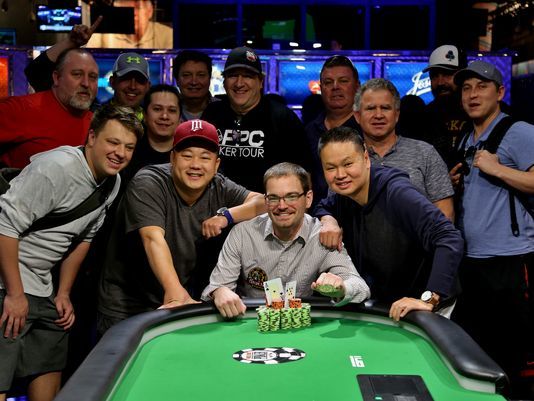

Me with my buddy John Reading, when he won his bracelet. Image credit: Tim Fiorvanti
No longer. Now I am a fan. I cheer for people. I tell them that I’m proud of them. I tell them that it was a hell of a run. I get a beer and I sit in the bleachers and I yell every time they win a hand. I tweet about them and tell people about them. Lifting someone else up doesn’t cost a thing. During the World Series of Poker we get a chance to do that every day. If you’ve been playing for a while, you know enough people that some friend of close acquaintance is deep in a tournament almost every day.
A deep run should remind us how much fun poker can be and how important it is to have people rooting for us. It should remind us to be rooting for all the good guys. It should remind us that shared joy is multiplied. It doesn’t matter if you play $75 tournaments at your local card room or $100,000 high roller events, when you have a deep run, you should enjoy the hell out of it. And when someone else makes that deep run, you should make sure they enjoy it just as much as you would.
On a side note, this is absolutely the most fun I have ever had, and I’ve done some wild shit in my life. #adrenaline
— Chris Wallace (@foxpokerfox) July 11, 2019
After a summer of running badly, it’s easy to hate the game. I do it far too often. But this deep run was a great reminder of why I love the game. Because there’s always someone to root for, and there’s always someone rooting for you. I play a game for a living. How many people get to do that? And I have an incredible circle of family and friends that support me, win or lose. The least I can do is give back as much of that love as I can possibly muster.
My goal for this year is to try to instill that love in my students. It’s something I’ve never talked about in lessons. I’ve always focused on strategy, hand reading, tells, anything that makes more money. I’ve even told students who can’t follow my advice that “I can’t teach you how to have more fun, that’s not what I coach, but I can teach you to make more money.”
I was wrong. All these years I was wrong. I can teach people how to have more fun, and it makes the game easier and it helps you get through the downswings. And that’s something I should have been teaching all along. So from now on, I teach people how to have fun and make money. And I’ll start by giving myself a few lessons, because the cash game grind is about to start back up and I’m going to be bored.
If you hear me complaining, remind me about this article. I’ll come back and read it once in a while if I lose perspective.
I’ve been an indirect student of Jonathan Little’s for several years. From his Instapoker quizzes, to his Secrets of Tournament Poker series of books, and every subsequent book thereafter, and now with his site PokerCoaching.com (and Floattheturn.com) that has released the 25k Platinum Coaching Series.
As Jonathan has been pumping out training content for years, it’s near impossible to keep track of, let alone ingest, every article / video / webinar he’s provided. There’s a lot.
So, when I was tasked to write a review of one his latest video series, ‘25k Platinum Coaching Sessions’, I was eager, curious, and to be honest a bit skeptical. I mean, I didn’t really expect to learn anything I didn’t already know. But I’m not necessarily who the program is intended for. Yet here I was, plowing through the 6+ hours of videos and being wowed by just how many theories both fundamental and advanced are provided.
Get the 25K Platinum Coaching Sessions module now: available as part of a $99 coaching bundle!
The concept for the series is Little’s coaching of Nikhil Segel, a recreational player from India who won a Platinum Pass from then-PokerStars ambassador Jaime Staples for the site’s incredible Players Championship held earlier this year ahead of the PCA in the Bahamas. The tournament would be the largest $25k buy in tournament in poker history, with over 300 players winning entries through various means courtesy of PokerStars, along with over 700 more who put up the $25k themselves.
The mission: convert Nikhil from a (by his own admission) rank amateur who primarily played freerolls and microstakes tournaments into a contender for life-changing money in the biggest tournament of his life. No biggie.
The 15-video series is a progression of the duo’s work together, and at its core is a series of hand history breakdowns (with Nikhil’s input throughout), but given Nikhil’s inexperience, Little has to try to drill as much into his student as quickly and thoroughly as possible. And believe me, there’s a lot! As I mentioned, I was wowed, and at times, Nikhil said he was a bit overwhelmed.
Let’s get into it.
The first hand we see is our student open-raising 27x in a SB vs BB situation. Yup, work to do.
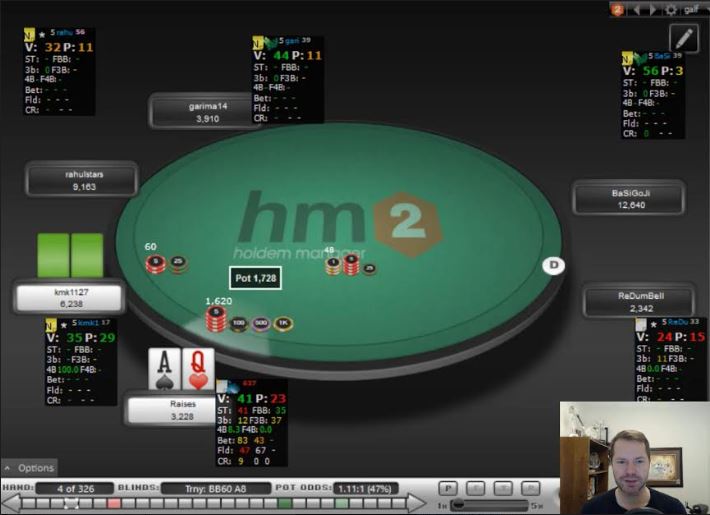

We’re going to have to dial back these raise sizes
This is where my skepticism as an experienced poker player kicked in. I was expecting to see all sorts of random nonsense that Little would have to just turn into basic ABC poker instruction, but silly me, this is one of poker’s best coaches we’re talking about and he’s not going to dumb this down. Sure enough, 17 minutes later after completing the first video, the skepticism was gone, and the eagerness and curiosity took over as I couldn’t wait to see where this journey went.
Aside from hand 1, there certainly were some big holes that needed addressing immediately including bet sizing, limping and starting hand selection (you’ll want to fire any Ace-x hand you ever see again across a room before this is done) to name a few.
But as I said, Little doesn’t hold back, and by the end of video 1 of the 25K Platinum Coaching sessions those topics have been addressed, along with:
Each of the 15 videos is like this. Almost every hand Nikhil plays is analysed and critiqued accordingly.
Video 2 introduces some staples of poker training, Pokerstrategy.com’s Equilab program, and a pair of resources from Little’s Float the Turn site, his push/fold app, and fold equity calculator.


Little takes Nikhil’s propensity for playing Ace-x and breaks down the numbers for it in a few situations, with all results showing that Ace-x (with a non-shove stack) is generally garbage.
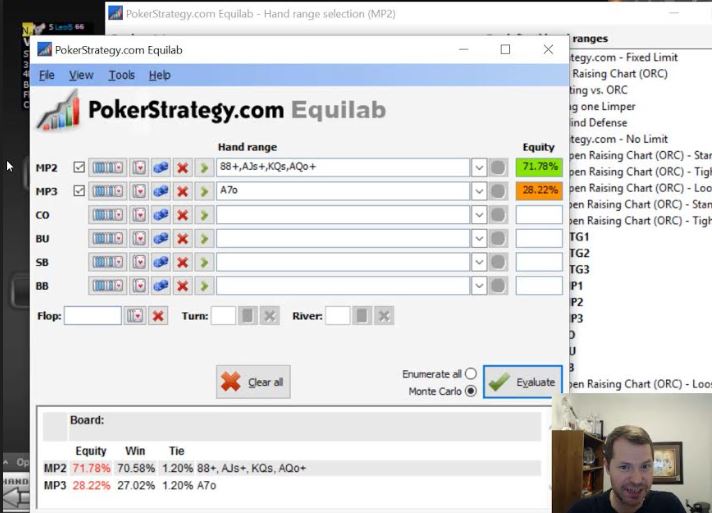

With the help of the push/fold app, charts, and fold equity calculator, Little emphasizes the importance of shoving or folding instead of calling in spots with hands like QJ.
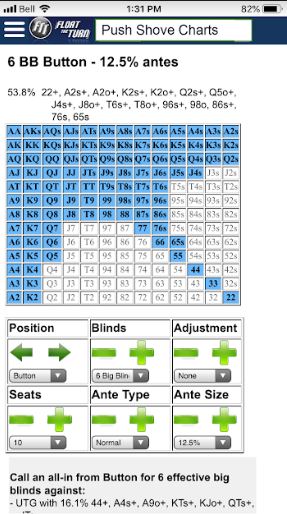

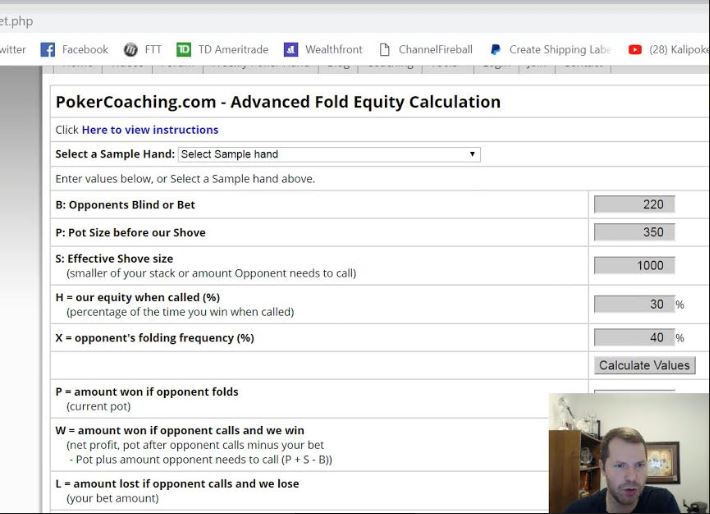

Along with the introduction of these tools of the trade, several other concepts are discussed as well, including 3-bet sizing and calling ranges vs. a 3-bet.
Videos 3 and 4 continue with Nikhil’s first set of pre-coaching hand histories. Several more key situations are discussed including play from the blinds, as well as a spot where he obviously should be playing the Ace-x. There are also a couple of fun hands discussing pocket aces, and when you should slow play to induce bluffs and get max value.
This first section is really about examining Nikhil’s level of play, giving him the groundwork to be more successful in the tournaments he plays regularly, and to have a shot in the $25k event. Plenty of concepts you will know, but examining how someone of Nikhil’s skill level plays and presenting a higher level of thought to him by Little is very intriguing.
The next 3 videos contain hand histories following Little’s first series of coaching sessions with Nikhil. Video 5 begins with an update from Nikhil, saying he’s working on trying to be tighter, with no more limping and not playing Ace-x (we’ll see about that…). Nikhil also says he still has concerns about his bet sizing, but Rome wasn’t built in a day, so let’s see how Little’s coaching is kicking in, shall we?
Immediately, we see that Nikhil’s hand selection is better, with a lot of trouble hands like KJo, QTo being played much more prudently by recognizing the strength of an early position raiser and folding.
His open-raise sizing is generally better as well with a few exceptions, notably in the small blind, where Little stresses the importance of increasing the sizing, given that you do not want to give the big blind pot odds to call, then having to play the hand out of position.
Flop bet sizing and board texture is also addressed in a couple of spots. Nikhil’s sizing in general is better, but he has the potential to get himself into trouble on highly coordinated boards that are likely to have hit his opponent’s range (see example below).


Now since the fundamentals are generally improving, how about we throw some high-level stuff in there to spice things up a bit? Little introduces an advanced play from the big blind, 3-betting ragged suited aces, kings and queens, then C-betting small on the flop! Yup, lots of fun things you can do in the blinds and here’s one of them!
Also, since we’ve got most of the issues out of the way with regards to weak aces and limping, now it’s time to introduce spots where it’s OK to do just that. The power of position!
Nikhil’s play shows improvement (“a million times better from the first session”, Little compliments), but there are still plenty of lessons to learn in this section, notably a couple of hard ones in post-flop play with suited connectors. Nikhil tends to overplay marginal made hands, which will be a point Little takes great care of working with him on throughout the series.
The 8th video of the 25K Platinum Coaching series stands on its own as an update on Nikhil’s mindset as the tournament approaches. It’s a good discussion on not overwhelming yourself and adding on unnecessary pressure.
Little goes through his student’s lengthy email, where he illustrates the amount of study and preparation he’s undergoing, including a breakdown of ‘strategies’ he’s preparing for the tournament. It’s obvious Nikhil is taking the upcoming tournament very seriously, but Little suggests he may be overwhelming himself with the amount of work he’s doing not only with him, but with other coaching sites. Little’s advice is to just prepare as best he can and play solid fundamental poker.
Another great point about mindset is brought up as Nikhil suggests several times that if he’s feeling overwhelmed or tilted at the table he will walk away and take a break. Little acknowledges this can be good at certain times, but with the amount of instances Nikhil suggests he’d leave, he’d be better to just sit there and “be sane” in most of them. Cooling off can be beneficial but missing too many hands would be detrimental.
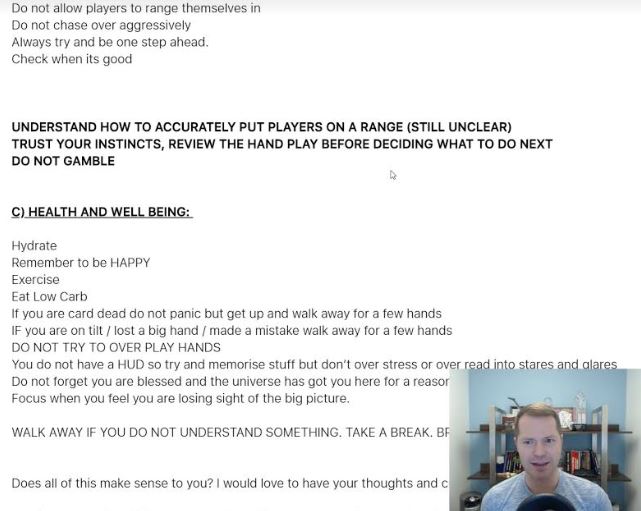

With the $25k fast approaching and Nikhil showing signs of mental fatigue from his hard work, some bad habits creep back into his game that Little must squash as he also adds to his student’s preparation.
Some poor hand selection and irregular pre-flop raise sizing pop up again, but post-flop play is where most of the work still needs to be done.
Nikhil’s post-flop tendencies to bet in poor spots or bet too large — allowing his opponents to play perfectly, while missing value in others — is really highlighted here. He tends to open himself up to getting blown off his hand too often when he should be looking to get to showdown (as illustrated below).


These situations are addressed and worked through very well with several situations showing a check-raise to be the optimal play (while others illustrate why it’s definitely not). This section will help any player with their post-flop game.
Video 11 deals primarily with short stack play and situations late in a tournament. Little wraps up this section acknowledging small blind raise sizing, short stack push/fold decisions and the marginal made hand trouble need to be worked on. As we get to the home stretch, let’s see what improvements are made.
The 12th video of the 25K Platinum Coaching series stands on its own as a 40-minute training session in shorthanded play as Nikhil navigates his way through a 6-max tournament.
In an email at the beginning, he acknowledges his concerns about regression, noting a recent series of bad results. Little tries to calm his fears with a reminder of how high-variance tournament poker is in general.
Adjustments when playing 6-handed are discussed throughout this video, hand selection will be somewhat looser, stats will appear wilder, but really 6-max is just like full ring with UTG, +1 and +2 removed.
That said, there’s still no excuse for what we see below, a stone bluff with air into a horror show of a board that could prove disastrous for our student!
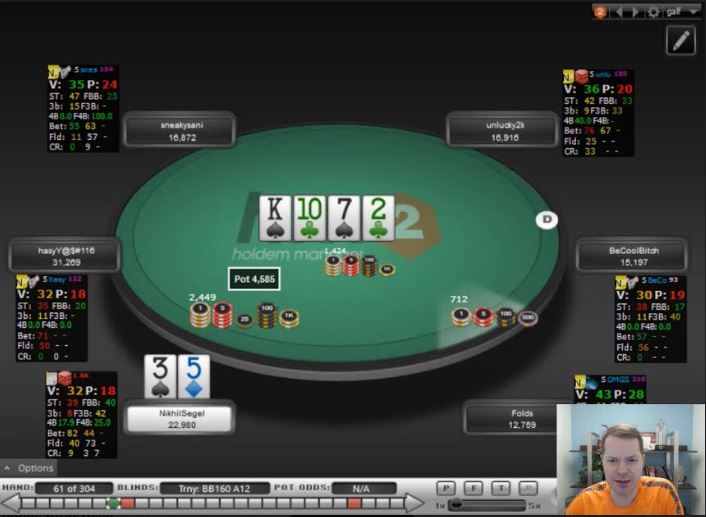

The final section of videos is a hand history of a tournament Nikhil wins shortly before he heads to the Bahamas. The main theme of this lesson is ‘take advantage of the mistakes your opponents will make’! Granted, this is still a micro stakes tournament, but the work Nikhil has put in shows, as he outplays his opponents and capitalizes on their egregious errors (see below).


One caveat – Ace-x still rears it’s ugly head and Little must implore him once more about the problems with reverse implied odds this hand can cause (“ask yourself, would you play K7o? The answer’s just no!”).
It is great to see how Nikhil has improved and how Little’s teachings have influenced his game. The final video deals with final table play, pressuring your opponents, more push/fold situations and ICM considerations.
Of course, there’s nothing like heading to the biggest tournament of your life coming off the high of a victory and seeing the fruits of your labour.
As I mentioned at the outset of this review, I was skeptical about what I may or may not learn from this video series. Now having watched the entire series, not only was I reminded of concepts that had maybe slid out of my game, but plenty more were introduced as well. The combo of a bombardment of information along with the story of Nikhil Segel’s progression throughout these lessons make for a tremendous training tool for poker players of all skill levels.
In summary, Jonathan Little’s 25k Platinum series is certainly one of the finest hand history training sessions available.
So I bet you’re wondering how Nikhil did at the PSPC in the Bahamas?!
He made it to day 2 with over 90,000 in chips from a starting stack of 60,000. However, his run ended there, but not in sadness as he called it “the best possible experience” and “one of the best days of his life”. Now if you don’t make the money, that’s about the best consolation prize you can get.
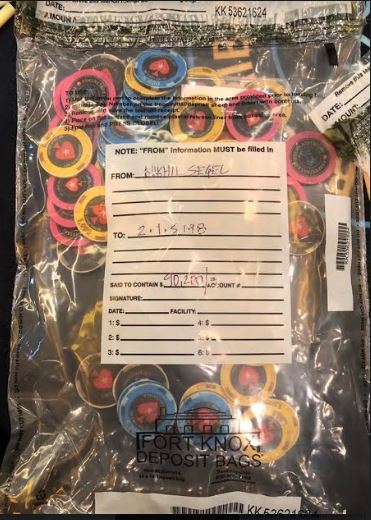

Busted #myultimatesweat ends. But I’m not sad. This has been the best possible experience thanks for all the love. @PokerStarsIN @PokerStars @PokerStarsBlog
— Nikhil Segel (@NikhilSegel) January 7, 2019
It was back in 1709, when British poet Alexander Pope wrote his famed “Essay on Criticism,” introducing the well-known saying, “To err is human, to forgive divine.”
We are only human, so we are bound to make mistakes now and then – perhaps more often than we would like. Because there are so many key decisions to be made, poker is a game where there are lots of opportunities to make the wrong decision. Most often, that mistake will be costly. And speaking of mistakes…
Let me share with you a hand I played the other evening at Larry Flynt’s Hustler Casino in Gardena (near Los Angeles), California. It was a $4-$8 limit game of Texas hold’em with ½ Kill. In the Under-the-Gun (UTG) position (just after the two Blinds), I was quite pleased to see A-A in the hole. That’s a made hand, and the best one possible that you can start with before the flop. The odds are 221-to-1 against being dealt this hand – about once in 7 hours, on average, at a live poker table. When playing poker online, for example at a Finnish poker online site like nettipokeri, the odds are the same, but you’ll see the hand much more often since you get dealt far more hands per hour.
Anyhow, holding pocket Aces, my usual goal is to play it against three but not more than four opponents. That gives my A-A a good chance to keep the lead; meanwhile, I can still build a decent-sized pot. (According to probability law, pocket Aces becomes an underdog if more than four players stay to see the flop with you.)
On that basis, I was prepared to raise pre-flop; but then I paused to question that decision: It was a rather tight table; from early position, a raise was likely to force out most – if not all of my opponents. (You can’t make any money if everyone folds.) So, I decided to slow-play this initial round (pre-flop) of betting, just calling to see the flop. Four opponents and I saw the flop.
#ThingsYouShouldntDoTwice Slow play aces. #poker
— Marvin Karlins, Ph.D. (@TheDuckman22) June 12, 2019
The flop came down: 7-9-J rainbow. I presumed that one or two opponents may have paired up. That was fine with me, as I confirmed my A-A in the hole. So, I opened the betting from my UTG position, and had three callers. There were no raises, so I felt comfortable that my pocket Aces was still well in the lead.
The turn put a King on the board. Considering my opponents’ hand ranges, most likely my A-A was still the best hand – at least, so I presumed.
More Poker Tips By George: Playing Against a LAG Maniac
The river paired the Jack on the board, giving me top two-pair, Aces and Jacks. I felt quite confident with my hand. I decided to open the betting from my UTG position. The next two opponents quickly folded; but then the player in the cutoff position raised it up! At that point, I paused to think it out. What might he be holding? Yes, he could have a Jack in the hole; that would give him trip Jacks on the river, which would be unfortunate for me. He might also be holding a straight. With only two suited cards on the board, a flush was not possible. Most likely, I rationalized, he held two-pair; but I had the top two-pair. So, I decided to just call his raise.
He turned up 8-10 suited. He had flopped a straight, and slow-played me until the river! I had lost a good-size pot. . .
So, let me ask you: Did I goof when I decided not to raise pre-flop from my UTG position with my pocket Aces?



Maybe the Poker Gods had seen enough, and they sent the second earthquake of the week to Las Vegas as penance for sticking Phil Ivey at an auxiliary table in the shuttered bowling alley?
An argument could be made that the bowling alley was a perfectly suitable place to put a poker player for a plebian event like The Big 50, where 28,371 humans dished out $500 to play in the largest poker tournament in the history of poker. But you would never expect tournament directors to allow anyone paying $10,000, let alone the great Phil Ivey, to spend Day 1 in the most prestigious poker competition of the year wedged between an unplugged refrigerator and a rack of 13-pound house bowling balls. That, apparently, was the last straw. The unseen forces of the Poker Universe were unhappy after a long month of shenanigans and they were no longer going to stay quiet about it.
After weeks of 30-minute bathroom lines, parking lot robberies, and tournament tables that required a blueprint from the Rio Maintenance Department to find, it was hard not to interpret the juddering lights above the Amazon Room as a preliminary death rattle for what has been the home of the World Series of Poker for 15 great years.


This area of poker tables used to be a bowling alley…
This isn’t the first time the World Series of Poker has grown too big for its britches. In the short year that followed Chris Moneymaker’s win in 2003, players saw the WSOP at Binion’s Horseshoe evolve from a well-attended family reunion atmosphere to an enormous fire hazard. The only thing that matched the volatility of the tournament’s growth was the drama within the Binion family as the Horseshoe finally fell out of their control. The full details of this nugget of poker history can be found in the two excellent articles by noted poker historian and authority Nolan Dalla here and here.
Not much remains of Binion’s to remind you of its time as host to the World Series of Poker. The “Horseshoe” is gone and the casino is now known as Binion’s Gambling Hall, a generic version of the old Binion’s brand that was probably devised as a cost effective way to avoid replacing all of the signs.


Just “Binion’s” now, no Horseshoe in sight…
The casino is in a constant state of revision, and currently the North entrance is torn up to make way for a second story bar and restaurant while most of the first floor is unrecognizable to anyone who has not visited since the last WSOP in 2004.
The few remaining artifacts of the Series that remain at Binion’s are the portraits of the Main Event winners. No fanfare is made of the famous Wall of Champions, and you’ll have to look around to find it along the brick dividing wall at the sportsbook near the rear of the casino.


The lack of a brick-and-mortar Poker Hall of Fame to preserve the game’s history and mark the passage of time is one of poker culture’s unfortunate, glaring omissions. Granted, many of the game’s most important people have been voted in to a Hall of Fame by a yearly election from a pool of players and writers, but without a physical presence it amounts to little more than a Poker Website of Fame.
Read More: It’s Time to Build a Physical Poker Hall of Fame
It’s difficult for the average fan to generate much excitement in the Hall’s current format as what has been called “a Mutual Admiration Society.” A true Hall of Fame has a mission of historical preservation, and it is a museum first and foremost.
The museum culture in Las Vegas is still in its infancy, and slow to grow compared to the other more mesmerizing activities in the region. The Neon Museum is an example of what a Las Vegas museum can offer as an attraction, but signs and lights are only part of the story, and many of the best collections of Vegas artifacts are still in the hands of private collectors and stores like Spinetti’s Gaming Supplies, which contains an exhaustive collection of gambling memorabilia as well as functional gaming tables for most casino games.
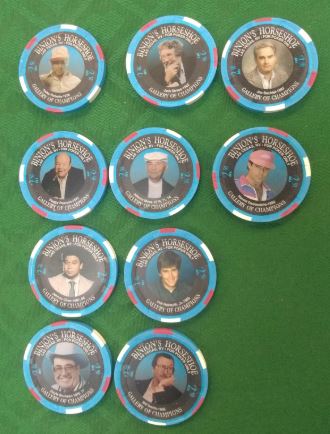

Limited Edition “Gallery of Champions” $2.50 poker chips sold at the 1994 WSOP. 1000 sets were made.
Today, Spinetti’s has grown to be considered an authority among casino collectors. They operate a table in the hallway of the Rio Convention Center during the World Series of Poker on behalf of Copag Cards, and there is hope for an opportunity to introduce some of the collection to WSOP visitors in the future.


1997 WSOP $500 Lammer Chip
For 15 years, the World Series of Poker has made its home at the Rio, but with an aging infrastructure and an awkward location, it remains a constant target of sale and demolition rumors. The recent merger of Reno’s El Dorado Resorts and Caesars Entertainment puts the Rio at the top of the list for a sale, and with its extended pause on renovations, it will take hundreds of millions of dollars just to make the casino complex competitive in today’s market.
Regardless of the property’s owner, it’s difficult to envision a future where the Rio Convention Center’s 160,000 square feet can keep pace with the WSOP’s growth expectations. The 2019 event might have yielded record-breaking fields, but the player experience has unfortunately often suffered as people had a difficult time navigating the crowded hallways during large events.
That said, the future is bright for the WSOP, and the greatest poker tournament in the world no longer has to worry about the occasional existential crisis. Interest in tournament poker is as high as it has been in some time, live poker is booming, and there are more catalysts for growth waiting as online poker is slowly legalized around the country.
The Powers That Be are not making a big deal out of it yet, but the Caesars Forum awaits, and the best guess for the first World Series of Poker on the Las Vegas Strip is 2021.


Caesars Forum is under construction behind the Linq and is expected to open in 2020.
The newest jewel in the Caesars empire will offer four ballrooms, two of which will be the largest in the world at 110,000 square feet apiece, the size of two current Pavilion Rooms and some change. The other two ballrooms will be 40,000 square feet, slightly larger than the Amazon Room. A total of 300,000 square feet of flexible meeting space will nearly double what the Rio offers, and the hallways will be able to accommodate very large fields. The inevitable move is a no-brainer for the World Series and for Caesars. The WSOP needs the space, and the timing of the annual event fits perfectly in the historically slow summer convention season.


Caesars Forum floor plan
There will be players and fans who are sentimental about the Rio, just as there were many who did not want to see the tournament’s time at Binion’s end, but sentimentality is dangerous in Las Vegas, a town that embraces change for the sake of change. Today you may be getting married in front of a beautiful mural that you thought you could visit for the rest of your life, but tomorrow it might be a Modelo ad. “So it goes.”
An authentic Poker Hall of Fame experience would help bridge the historical eras of the World Series and preserve the documents and memorabilia that tell the stories of its most interesting players. The museum could be as simple as a pop-up attraction for the length of the WSOP every summer to entertain thousands of visitors during their time away from the tables, or it could find a permanent home to draw players and fans throughout the year. Regardless of where the World Series of Poker is going, it’s important that its stakeholders do justice to the event’s history by investing more than lip service into the game’s historical legacy.
Several years ago, cryptocurrency was an idea whose uncertain destiny was yet to be determined. Today, crypots are no longer an obscure topic and most people with at least some tech knowledge are at the very least aware of some major types of cryptocurrencies, such as Bitcoin.
Online gambling and online poker have played an important role in helping bitcoin become what it is today. These days, there are dozens of card games sites where you can play with bitcoin in one way or another. While it was initially an alternative for people who didn’t have access to other banking options, these days many players choose to play with bitcoin for various reasons, such as speed of withdrawals, a greater degree of privacy, etc.
All in all, you should have no problems finding a card games site that accepts Bitcoin and fits your needs and expectations these days. The three we briefly review in this article are most likely to fit a majority of players but there are other options out there as well if you’re not happy by what’s offered here.
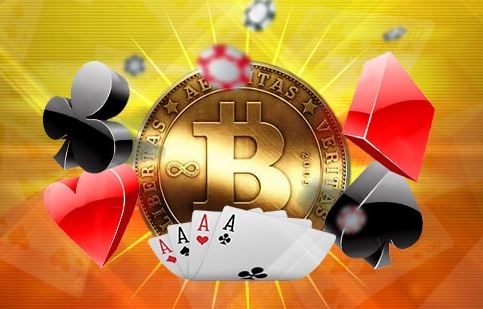

Image credit: Bitcoingg.com
Launched back in 2001, Americas Cardroom has been around for a while. The site was one of the early adopters of bitcoin, primarily as a way to make it possible for US players to deposit and withdraw funds and avoid various restrictions that came about after the UIGEA.
These days, ACR features a wealth of options for players of all shapes and sizes. The rich online tournament schedule is coupled with a versatile offering of cash game tables featuring poker variations such as Texas Hold’em, Omaha, Omaha 8, 7 Card Stud, 7 Card Stud 8, and 6+ Hold’em.
In addition to this, the site also features a variety of promotions and bonuses for players to take part in. While ACR may have had its problems over the years, it still remains a card game site that accept bitcoin deposits.
Bovada Poker has been online since 2004 and it is one of the better known names in the world of online poker. Like ACR, Bovada has been heavily focused on the US market (despite its short departure in 2016) and, as such, has introduced bitcoin as one of their favorite deposit and withdrawal methods.
Bovada has managed to get their affairs in order in the banking department, becoming one of the fastest-paying US-facing sites with regards to bitcoin withdrawals. Unlike some other cardrooms, which still made players wait despite all the possibilities provided by new technology, Bovada has managed to set up a system where cashouts to players’ BTC wallets are almost instantaneous.
Ignition Poker came to life during the short period of Bovada’s absence. It was meant to be the substitute for Bovada, taking over the US share of the market. Although Bovada later came back, Ignition lived on as a standalone poker site and continues to exist as one of the leading US-facing operators.
This particular site was offering bitcoin deposits right from the get-go. Realizing particular needs of their main target market, Ignition made sure players could use the most popular cryptocurrency to top up their accounts and cash out their winnings in a simple, reliable, and, most importantly, safe manner.
These three operators are among the leading card game sites that accept bitcoin deposits. While none of them is perfect they all also have something unique to offer to the players, with the common bond being the ability to transact in cryptocurrencies. Players new to bitcoin deposits will also find a wealth of resources on the topic provided by the operators, making it easy to get started and slowly enter the world of what could be the future of online transactions.
*Disclaimer: Cardplayer Lifestyle does not actively endorse cryptocurrency investment or patronage of US-facing online poker sites that are not fully licensed and regulated.
While live and online poker are the same game as far as the rules are concerned, they tend to be two very different animals in almost all other aspects. This is true for all poker variants but especially No Limit Hold’em, which is by far the most played one in brick and mortar venues and countless poker sites. Recognizing and understanding these 7 key differences can be crucial for properly adjusting your poker play for the particular setting.


Image credit: gamerlimit.com
If you compare the two games at the same level, be it a $200 NL cash game or a $100 buy-in tournament, you’ll find that live games are, almost without exceptions, way softer. There are several reasons for this, the main one being the fact that the range of available games online is much wider. For example, you can play for stakes as low as NL10 online or buy into tournaments for $1 or less. So, what’s usually the lowest or one of the lowest levels live is often a mid-stakes game online.
One of the biggest adjustments online players have to make when transitioning to live games (or even when playing an occasional live sessions) is with regards to the number of hands per hour you’re going to see. Since you don’t have an option to multi-table and live hands take longer to complete, most players won’t get to see even a third of hands per hour they’re used to seeing online.
Live poker is slow and social, while online poker is asocial and fast. Completely different economic models for “casino.”#CSCW2018 pic.twitter.com/HIWR5VkkqH
— Dr. Jessica Vitak (@jvitak) November 7, 2018
These days, all serious online players rely heavily on various poker tools, such as Poker Tracker or Hold’em Manager. These programs collect and update the information about all the players you’ve ever played with and you can use this info to make your decisions in the future. Of course, live, you don’t have access to any of these tools and the only stats you have at your disposal are what you can pull back from your memory of previous sessions or from the poker notes on your phone, if you’re really diligent.
If you come from a background where you play games online at places like Slotty Vegas and prefer online poker in general, you might initially be shocked to see how many players are still more than happy to open limp with a wide range of hands and see what happens. This is true for both live tournaments and cash games as it is really much different from online games where people tend to either raise or fold first in, with only an occasional limp thrown in to the mix. This calls for some serious strategy adjustments and also requires you to stay focused as it is all too easy to join the fun and follow suit.
Because people are so keen to play hands in live games, you’ll simply have to navigate more multi-way hands. Many pots, especially in cash games where stacks are deeper, will go three or four ways to the flop, which is something you need to account for. For example, your percentage of continuation bet with air will have to be lower because with more players involved, you’re less likely to get folds from everyone. At the same time, of course, it will be much easier to get value from your big hands. Online, it’s entirely different ballgame, with players taking great care not to get involved in too many hands to begin with.
While playing online, you’re seated behind your screen and you try to make your decisions based on all sorts of numbers appearing on the said screen. Although you can take the same approach to live tables and expect to be quite successful, having some people skills can be very advantageous for live play. If you’re able to get the conversation going in the midst of a tough decision, you might gather some valuable information that could help you figure out what’s up (i.e., if they’re bluffing or value betting, etc.). On top of this, if you’re a friendly and easy-going person in general, people might be less likely to go after you and won’t be as keen to take your money.
Because you get to play fewer hands per hour and because games are, in general, more volatile, live players tend to experience more short-term variance. If you lose a few big pots in a row in live games, it might be a while before you get to another similar spot where you can recoup your losses. What takes several hours online can often take days or even weeks of live poker play. Because of this and because the range of available stakes isn’t nearly as wide, it is very important to properly manage your live poker bankroll.
You can find yourself in a variety of different situations at a poker table, but 3-bet pots are certainly among the most complicated and most important spots in Texas Hold’em. Thanks to the pre-flop action, these pots are bloated, which means they are worth fighting for. At the same time, trying to win in these situations against all odds can end up being very costly.
In this short article, we’ll give you some straightforward tips for navigating 3-bet pots as a caller, i.e. when another player is driving the action. Establishing a good general strategy for these situations is very important for crushing live poker and online games, so hopefully this advice will help you do exactly that.


Playing in 3-bet pots can seem like an appealing proposition because of all the money going in before the flop but also because of implied odds after the flop. However, the second part of this idea goes out of window when you’re up against a short stack, sitting with around 20 to 30 big blinds.
Hands such as small pocket pairs or suited connectors tend to play very well in 3-bet pots, especially when you have position. The power of these hands comes not just from flopping very strong hands but also flopping draws, which give you enough room to move your opponent off their holdings with bets and raises.
Short stack ninjas killin Us!
Lost another to a shorty AQs<JJ down to 400k at 12/24k. Time to show My Short Stack Ninja Skills— Zal (@ZalIrani) May 7, 2014
When you’re up against a short stack, though, you simply won’t have enough space to implement these bluffs, so you’ll have to rely on actually hitting a good hand, which won’t happen often enough. When someone 3-bets from a short stack, their range is usually stronger and your implied odds are very low, so you should avoid getting involved with these players.
When considering playing a 3-bet pot as a caller, make sure to adjust your calling range based on whether you’ll be in position or out of position after the flop. If the former is the case, you should keep your hand range much tighter and either 4-bet or fold as your preferred options.
It is true that hands such as small pocket pairs and suited connectors play well in 3-bet pots. However, if you’re not in position, you’ll struggle to realize your equity with these hands even when you hit the flop hard. Since you’ll be the first to act, your opponent will have much more freedom and control in the hand, making it hard for you to win a big pot, unless you both really connect with the board.
Of course, you should still play decent hands and you can make an occasional call with a small pocket pair against some weaker players. In general, however, your calling range in 3-bet pots should be significantly tighter if you’ll have to play the rest of the hand out of the position.
You don’t always have to be the caller in these spots. It is a good idea to mix in a 4-bet with some bluffs, especially when out of position, and try to win the pot right then and there.
This is a very strong play when you have ICM poker strategy considerations in MTT, and players are forced to fold even quite strong holdings.
When deciding whether to go for a 4-bet, base you decision on your hand (most importantly whether it contains blockers) and also any stats you have on your opponent if you are playing online. You should be more open to the idea of 4-betting against someone you know is a liberal 3-bettor.
Players with a high 3-bet percentage tend to not get involved in 4-bet pots simply because they rely on the power of their 3-bets to win money. When they face unexpected aggression, they’ll often just give up, unless they do happen to find a premium hand.
This basically means that they will be folding much more than they should and letting you take down the pot uncontested much of the time, so take advantage of that.